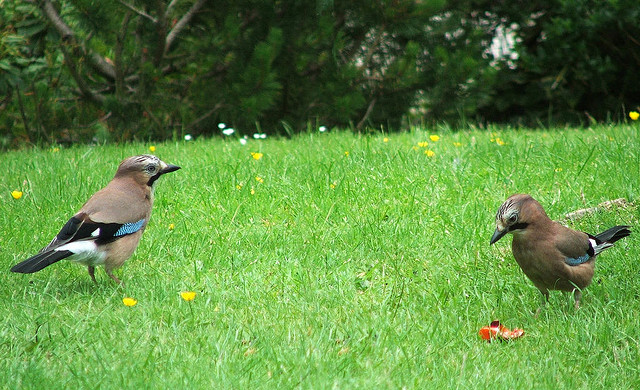Eurasian Jays and the 6th Language of Love

Image 1: Eurasian jays (Garrulus glandarius) (Kaisla, 2012)
There are five languages of love that the world know of today, but what do we know about the animals’ love languages? According to a recent research, the Eurasian jays (Garrulus glandarius), we may have just found the world’s 6th love language – predicting food preferences (Ostojic et al., 2013). This is similar to us giving chocolates to our loved ones – we want to give what he/she wants the most to increase our value as a lover (Adams, 2013). These jays are capable of attributing desires to their mates, similar to humans’ state-attribution – defined as “ability to explain and predict others’ behavior in terms of desire-states” (Ostojic et al., 2013).
This behaviour is reinforced during courtship feeding – when males feed females after mating to strengthen their bond (Royama, 1966). Ability to predict food desires of partners is important as it increases value of the male jay as a mate (Ostojic, 2013).
Image 2: Eurasian jays (Lowkes, 2005)
The mated jays were separated with a transparent screen while the males watch their partners being fed with different types of larvae, and then reunited after a period of time. The males were found feeding their partners with the type of larvae that she had less of previously (Ostojic et al., 2013). Several experiments conditioned differently took place and it was found that the larvae that males choose to give their partners was not influenced by the females’ act of acceptance or rejection, nor was it affected by his own food desires (Ostojic et al., 2013).
Image 3: Eurasian jays courtship feeding (Kim, 2012)
The male needs to see what their partners were fed with prior to his own food-sharing with her (Ostojic, 2013). By watching her eat, the male can then respond to changes in her state of desire and feed her with food she currently wants the most (Ostojic et al., 2013).
A similar behaviour is also observed among cotton-top tamarins (Saguinus oedipus), where vocal callings are signals for food preferences (Tannenbaum et al., 1991).
Literature Cited:
Ostojic, L., R. C. Shaw, L. G. Cheke & N. S. Clayton, 2013. Evidence suggesting that desire-state attribution may govern food sharing in Eurasian jays. Proceedings of the National Academy of Sciences, 110(10): 4123-4128.
Royama, T., 1966. A re-interpretation of courtship feeding. Bird Study, 13(2): 116-129.
Tannenbaum, P. L., A. M. Elowson & C. T. Snowdon, 1991. Food-associated calls correlate with food preferences in cotton-top tamarins. Animal Behaviour, 42(6): 931-937.
Ostojic, L. 2013. Monogamous birds read partner’s food desires. University of Cambridge, 15 Feb 2013. URL: http://www.cam.ac.uk/research/news/monogamous-birds-read-partner%E2%80%99s-food-desires (accessed on 29 Mar 2013).
Adams, P. 2013. Romantic Jays Take Care To Feed Their Mates What They Particularly Crave. Popular Science, 06 Feb 2013. URL: http://www.popsci.com/science/article/2013-02/romantic-jays-take-care-feed-their-mates-what-they-particularly-crave (accessed on 29 Mar 2013).
Images:
“Eurasian Jays,” by Richard Lowkes. Flickr, 13 Jun 2005. URL: http://www.flickr.com/photos/richardlowkes/19169650/ (accessed on 29 Mar 2013).
“Eurasian Jay (Garrulus glandarius)” by Tapio Kaisla. Flickr, 25 Feb 2012. URL: http://www.flickr.com/photos/scirpus/6789097534/ (accessed on 29 Mar 2013).
No Title, by Hankyu Kim. Harrier Blog, 11 Aug 2012. URL: http://3.bp.blogspot.com/-vx7R3f48fgc/UCdHhSRu5CI/AAAAAAAAAOk/u7i9fJ3gsQw/s640/12.jpg (accessed on 29 Mar 2013).
Written by: Soh Si Ying (A0069635U), Group 04

